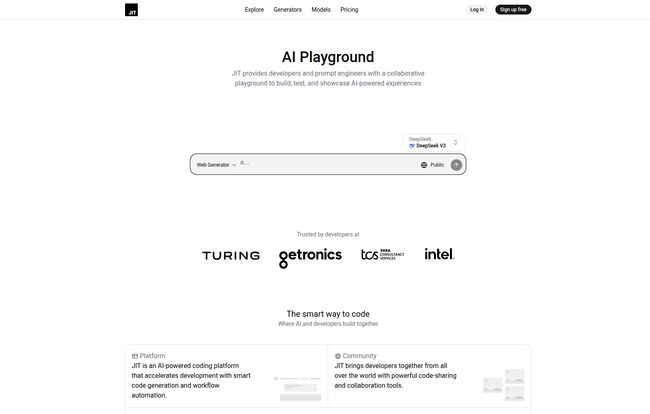We’ve all been there. Staring at a blinking cursor, the ghost of a brilliant idea for an app or a feature floating just out of reach. You know what you want to build, but the path from idea to functional code feels like a trek across a desert. For years, the answer was more Stack Overflow tabs than any one browser should have to handle. And then, AI coding assistants arrived.
They came in fast, like a sudden gold rush. Every week, it seems there's a new tool promising to write all your code for you. Some are good, some are… less so. But recently, I stumbled upon one that felt a little different. It’s called JIT.codes, and it’s been on my mind a lot. It positions itself not just as a code generator, but as a community and a playground. And I have to say, I was intrigued.
So, is it just another drop in the AI ocean, or is there something more to it? Let's get into it.
So What Is JIT.codes, Really?
On the surface, JIT.codes is an AI coding assistant. You talk to it, tell it what you need—a React component, a Python script, a full-blown dashboard—and it spits out code. Standard stuff, right? But that’s where the comparison to other tools starts to fall apart.
The best way I can describe it is this: most AI tools feel like a vending machine for code snippets. You put in a prompt, you get a result. JIT.codes feels more like a bustling, collaborative workshop. It’s built around the idea of conversation and experimentation. You don't just give it a single command; you have a running chat, refining your idea, asking for changes, and seeing the results update in real-time. It’s a much more organic way of working with an AI partner.
It’s also a place where developers share what they’ve built. The homepage is full of wild, creative projects—from little games to complex data visualizations. That community element makes it feel less like a sterile utility and more like a creative space.
The Conversational Coding Experience
This is the core of the whole thing. The “AI Playground,” as they call it. You open a chatbox and just start… talking. “Create a modern, minimalist dashboard for an inventory system.” And it gets to work.
But the real magic is the multi-mode chat. This is something I haven't seen executed quite this way elsewhere. You can have it generate a response using two (or up to four on the Pro plan) different AI models at the same time. Imagine asking for a JavaScript function and seeing how GPT-4, Claude 3, and Llama 3 would each tackle the problem, side-by-side. It’s an incredible way to learn the nuances of different models and pick the output that best fits your style or needs. No more hopping between different AI chat windows. It’s all right there.
You can see your project come to life as you chat, tweaking and customizing as you go. It’s a powerful workflow that seriously cuts down on the back-and-forth of copy-pasting code into your editor only to find it doesn’t work.

Visit JIT.codes
It’s a Community, Not Just a Utility
I keep coming back to this because I think it’s the biggest differentiator. The platform encourages you to make your creations public (though private mode is available on paid plans). This has created a gallery of inspiration. I spent a good hour just browsing what other people had made—an interactive 3D solar system, a colorful matching game for kids, an animated water-like background made with pure CSS.
This isn't just for show. It’s a fantastic learning resource. You can see the prompts others used to get their results, effectively learning how to better “speak” to the AI. For a beginner, this is gold. For a seasoned pro, its a great way to get a spark of inspiration when you’re feeling stuck in a rut.
Let's Talk Models and Money (The Nitty-Gritty)
Alright, this is where things can get a bit complicated with any AI tool: the cost. JIT.codes operates on a freemium model with subscription tiers and a credit system. Let’s break it down in plain English.
The Tiers Explained
There are three main plans. The Free plan is genuinely useful, which is a huge plus. You get 2,000 bonus credits to start, you can use the multi-mode chat with up to 2 AI models, and you get access to everything public. For casual use or just trying things out, it's perfect.
The Plus plan, for about $3 a month (billed annually), is the first paid step up. The main perk here is privacy. You get private chatboxes, so your super-secret-world-changing-app-idea stays, well, secret. A small price for peace of mind.
The Pro plan is where things get really interesting, for $12 a month you get a huge credit bump (10,000 bonus credits), can compare up to 4 AI models at once, and get priority support and early access to new features. This is for the power users and professionals who are integrating JIT.codes deep into their daily workflow.
Understanding the Credit System
This is super important. Not all AI models are created equal, and they don't cost the same to run. JIT is very transparent about this. On their pricing page, they have a detailed table showing how many credits are used per 1,000 tokens (chunks of text) for input and output on each model. For instance, the mighty GPT-4o is one of the more expensive models, while others like DeepSeek Coder V2 are much cheaper. There's even a model that's completely free to use! This means you have direct control over your spending. If you're doing something simple, use a cheaper model. If you need the big guns, you can fire up GPT-4 and just be mindful of the cost.
You can also buy extra credits if you run out, starting at $2.40 for 10,000 credits. I appreciate this a la carte approach. It feels fair.
My Honest Take on JIT.codes
After playing around with it for a while, I’ve got some thoughts. No tool is perfect, after all.
What I Love
The multi-model comparison is, without a doubt, the killer feature. It's a fantastic way to both learn and ensure you're getting the best possible code. The community aspect also feels genuinely refreshing in a market full of faceless tools. And the transparency around the credit system is a big win for me. I like knowing exactly what I’m spending and why.
What Gives Me Pause
The credit system, while transparent, means you have to stay on your toes. If you're not careful and leave GPT-4 running for every little query, you could burn through credits faster than you expect. It's a double-edged sword. Also, the classic debate: how much do you rely on the AI? It’s an amazing accelerator, but it's easy to see how it could become a crutch, potentially stifling the problem-solving skills that make a great developer. But that’s a conversation for the entire industry, not just a knock on JIT.codes.
Who Is This Tool Actually For?
I see a few groups getting a ton of value here:
- Beginners & Students: The conversational approach and the ability to see how others build things is an incredible learning environment. It’s like having a patient, knowledgeable tutor on call 24/7.
- Frontend Developers & Prototypers: Need to quickly mock up a UI component or a user flow? This is your new best friend. It can shave hours off the process of building visual elements.
- Seasoned Professionals: While you might not use it to architect a complex backend system from scratch, it’s amazing for blasting through boilerplate code, writing tests, or just getting a second opinion on an approach.
Frequently Asked Questions
- Is JIT.codes really free to use?
- Yes, there's a forever-free plan that is quite generous. It includes bonus credits, public chatboxes, and access to the multi-mode feature with up to two AI models. It’s more than enough to get a real feel for the platform.
- How do the credits work, and can they get expensive?
- You use credits to pay for the processing power of the AI models. Different models have different costs, which JIT.codes clearly lists. You have control over which model you use, so you can manage your spending. It can get expensive if you exclusively use the most powerful models, but it's very manageable if you're mindful.
- Can I keep my code private on JIT?
- Absolutely. The Plus and Pro plans offer private chatboxes, ensuring your code and conversations are not public. The Free plan's creations are public by default to contribute to the community aspect.
- How is this different from something like GitHub Copilot?
- Copilot is an autocompleter that lives inside your code editor, suggesting code as you type. JIT.codes is more of a collaborative, conversational partner in a separate environment (the “Playground”). You build and refine entire components or apps through chat, often comparing multiple AI outputs at once. They solve similar problems but in very different ways.
- What kind of AI models can I use?
- They offer a wide range! You can access models from OpenAI (GPT-4, GPT-3.5), Google (Gemini), Anthropic (Claude 3), Meta (Llama 3), Mistral, and others. This variety is one of its biggest strengths.
Final Thoughts
I came into this review expecting to see just another AI code generator. I was wrong. JIT.codes is a thoughtful, well-designed platform that understands something fundamental: development is often a conversation. Whether it's a conversation with a colleague, with yourself, or now, with an AI.
By focusing on that conversational flow and building a community around it, JIT.codes has carved out a really interesting niche for itself. It’s a powerful tool, a fascinating learning environment, and frankly, a lot of fun to use. If you’re in the dev world and you’re curious about how AI can fit into your workflow in a more creative way, I’d say you owe it to yourself to open up the playground and start a conversation.



